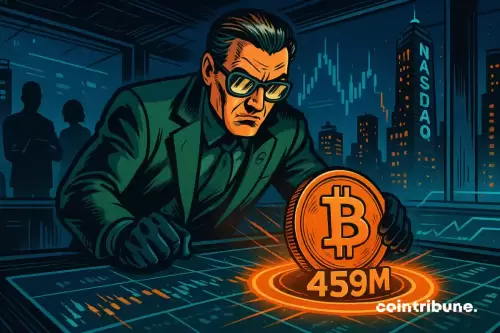 |
|
 |
|
 |
|
 |
|
 |
|
 |
|
 |
|
 |
|
 |
|
 |
|
 |
|
 |
|
 |
|
 |
|
 |
|
Cryptocurrency News Articles
South Korea's Stablecoin Debate: Shaping the Future of Digital Finance
May 12, 2025 at 08:31 am
Amidst the political hustle and bustle in South Korea, a fiery debate has erupted over the creation of a won-based stablecoin.

Amidst the lively hustle and bustle of South Korea’s upcoming elections, a fiery debate has erupted over the creation of a won-based stablecoin. But this clash isn’t merely a local squabble; it marks a significant chapter in the cryptocurrency narrative that holds valuable lessons for economies worldwide.
At the heart of this vision lies Lee Jae-myung, a seasoned frontrunner from the Democratic Party. He dreams of a future where South Korea spearheads a robust stablecoin market, safeguarding national wealth from dissipating across international borders. This proposition comes at a time when digital currencies are weaving seamlessly into the fabric of global economies.
Lee Jae-myung envisions a scenario where South Korea races to embrace and innovate in the crypto space before it’s left behind. However, not everyone shares this visionary stance. Enter Lee Jun-seok, the fiery torchbearer of the Reform Party, with a contrasting viewpoint that resonates with cautionary tales and vivid memories of past crypto mishaps.
Lee Jun-seok’s skepticism is deeply rooted in the haunting events of 2022’s Terra-Luna collapse—a catastrophic event that unfolded when Terra’s stablecoins, including KRT, failed spectacularly. The debacle saw massive financial losses, leaving thousands of South Koreans heartbroken and wary.
As the dust settles on that turbulent chapter, Lee Jun-seok now vocalizes stark warnings against repeating past mistakes. He criticizes any move toward stablecoins that aren’t grounded in tangible assets. Highlighting Terra’s flawed model, which relied on a volatile sister coin to maintain the peg of its stablecoins, Lee Jun-seok asserts that stability in cryptocurrencies can’t be an illusion conjured through algorithms and market speculation.
For him, the lesson from Terra is clear: Only real assets backing stablecoins are crucial to genuine stability, an assertion that ties into broader concerns in the U.S. and EU about stablecoins being used for illicit capital flows.
Stepping into the discussion with a keen interest in economic philosophy, former Democratic Party lawmaker Kim Byeong-wook helps to differentiate between algorithmic extremes and the potential for stablecoins to contribute to a stable macroeconomic environment.
He notes the international consensus—ranging from Washington to Brussels—that only collateralized stablecoins, backed by physical assets and operating with complete transparency, have the potential to earn the trust of multiple economies and regulators. These tokens, he asserts, represent a path forward, promising security through verifiable reserves and redemption guarantees.
While Lee Jae-myung and his supporters envision South Korea as a pioneering force in the digital asset space, Lee Jun-seok’s warnings demand a cautious approach. This debate isn’
Disclaimer:info@kdj.com
The information provided is not trading advice. kdj.com does not assume any responsibility for any investments made based on the information provided in this article. Cryptocurrencies are highly volatile and it is highly recommended that you invest with caution after thorough research!
If you believe that the content used on this website infringes your copyright, please contact us immediately (info@kdj.com) and we will delete it promptly.
-

-

- Bitcoin Solaris Enters Phase 3 of Its Public Token Presale, Prepares to Launch Nova App
- May 15, 2025 at 12:25 am
- TALLINN, Estonia, May 14, 2025 (GLOBE NEWSWIRE) -- Bitcoin Solaris, a next-generation blockchain platform engineered for speed, scalability, and accessibility, has entered Phase 3 of its public token presale
-

-

- The Sui blockchain SUI $3.65 2024-05-14
- May 15, 2025 at 12:20 am
- SUI $3.65 24h volatility: 5.3% Market cap: $12.18 B Vol. 24h: $1.76 B network has been making inroads in the decentralized finance (DeFi) space as it positions itself as a formidable competitor to Solana SOL $150.70 24h volatility: 2.6% Market cap: $78.04 B Vol. 24h: $3.80 B .
-

-

-

-

-

- XRP (XRP) Is Still in the Early Stages of a Bull Market as Data from Binance Shows Rapid Absorption of Sell-Side Pressure
- May 15, 2025 at 12:05 am
- Ripple (XRP) is still in the early stages of a bull market as data from Binance shows rapid absorption of sell-side pressure. XRP price is up by 20% in the last seven days, and it has overtaken Tether (USDT) to emerge as the third-largest crypto after Bitcoin and Ethereum.




























































